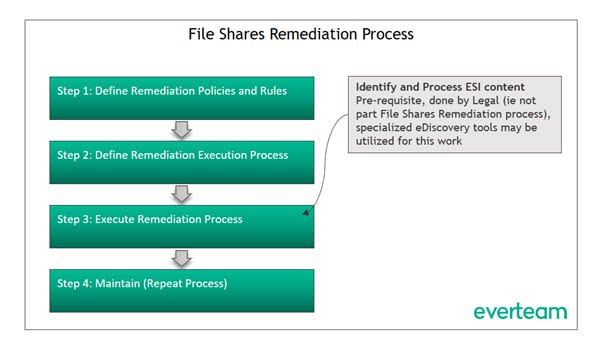I want to dig a little deeper into what is involved in Step 2 of the Shared Drive Remediation process… the Definition of the Remediation Execution Process.
Once the remediation policies have been defined (rules about what defines various classes of Information Assets and what actions to take on them), the next step is to define in detail the actual remediation process from an execution point of view:
| Activity | Description | Notes |
| Survey and Inventory File Shares | Identify and generate an inventory of the File Shares within the organization | The foundation of the Map |
| Estimate Data Volumes | Assess the volume of content located within the various File Shares | Guesstimate? |
| Identify business nature of content | Identify the business nature of the content within each File Share | – |
| Define final state each File Shares | Determine the desired final state of each of the File Shares (or groups of them):
| Take into account the overall Digital transformation and IT strategy of the organization |
| Define batch-based remediation process | Define a batch-based remediation execution process:
| – |
| Provision File Analytics solution needed for File Shares remediation work | Assess infrastructure requirements for the File Analytics solution and provision the infrastructure:
| – |
| Prioritize processing of batches | Prioritize the processing of batches and batch groups:
| Example: Abandoned File Shares for Completed Projects or File Shares of Departed Employees. |
| Define exception handling | Define what constitutes an exception to the processing rules and how these exceptions are handled:
| Example, missing metadata element that is deemed to be mandatory for classifying a record |
| Define monitoring and reporting | Define monitoring and reporting framework:
| – |
| Define a RACI model | Define a RACI model for remediation work to be performed. | RACI = Responsible, Accountable, Consulted, Informed |
| Obtain internal approvals | Obtain the necessary internal approvals for the policies as well as the start of remediation work:
| – |
As stated previously, dealing with ESI is not necessarily part of the File Shares Remediation process. HOWEVER, it is a step that MUST precede any actual execution of remediation work.
Coming up next I will explore the definition of ROT content and the issues involved in it.
Check out the full series to get caught up and subscribe to our newsletter to keep up to date on all our content.


